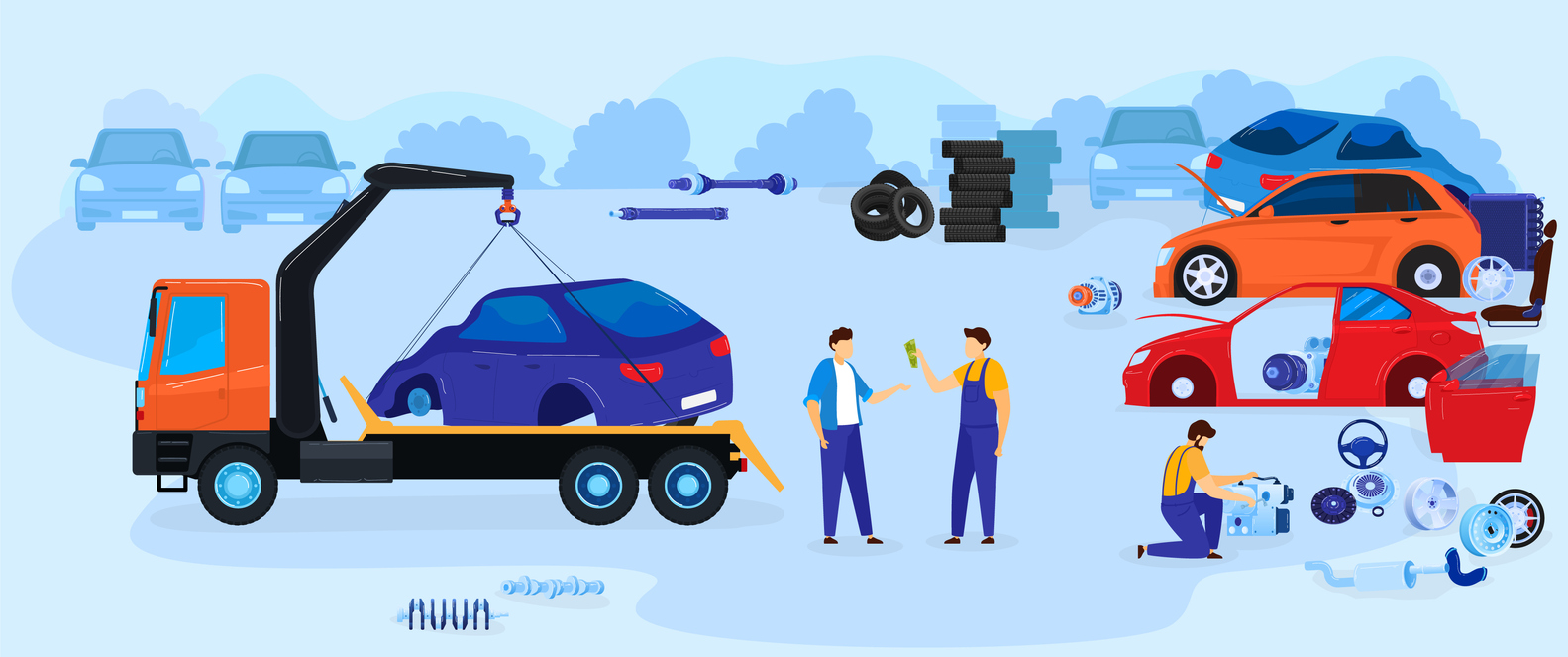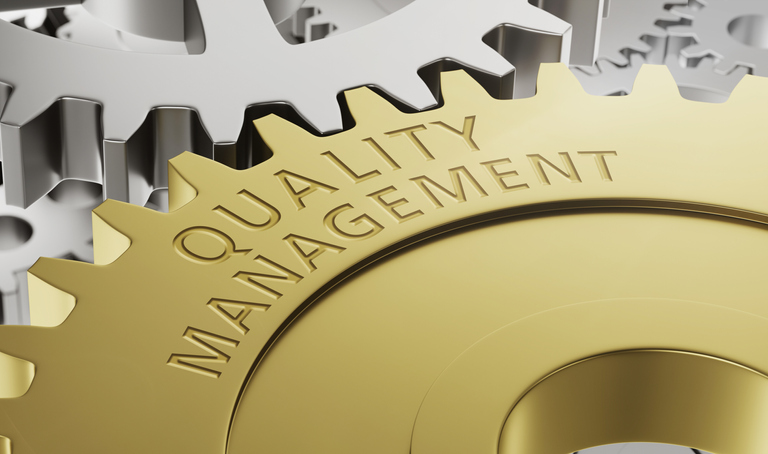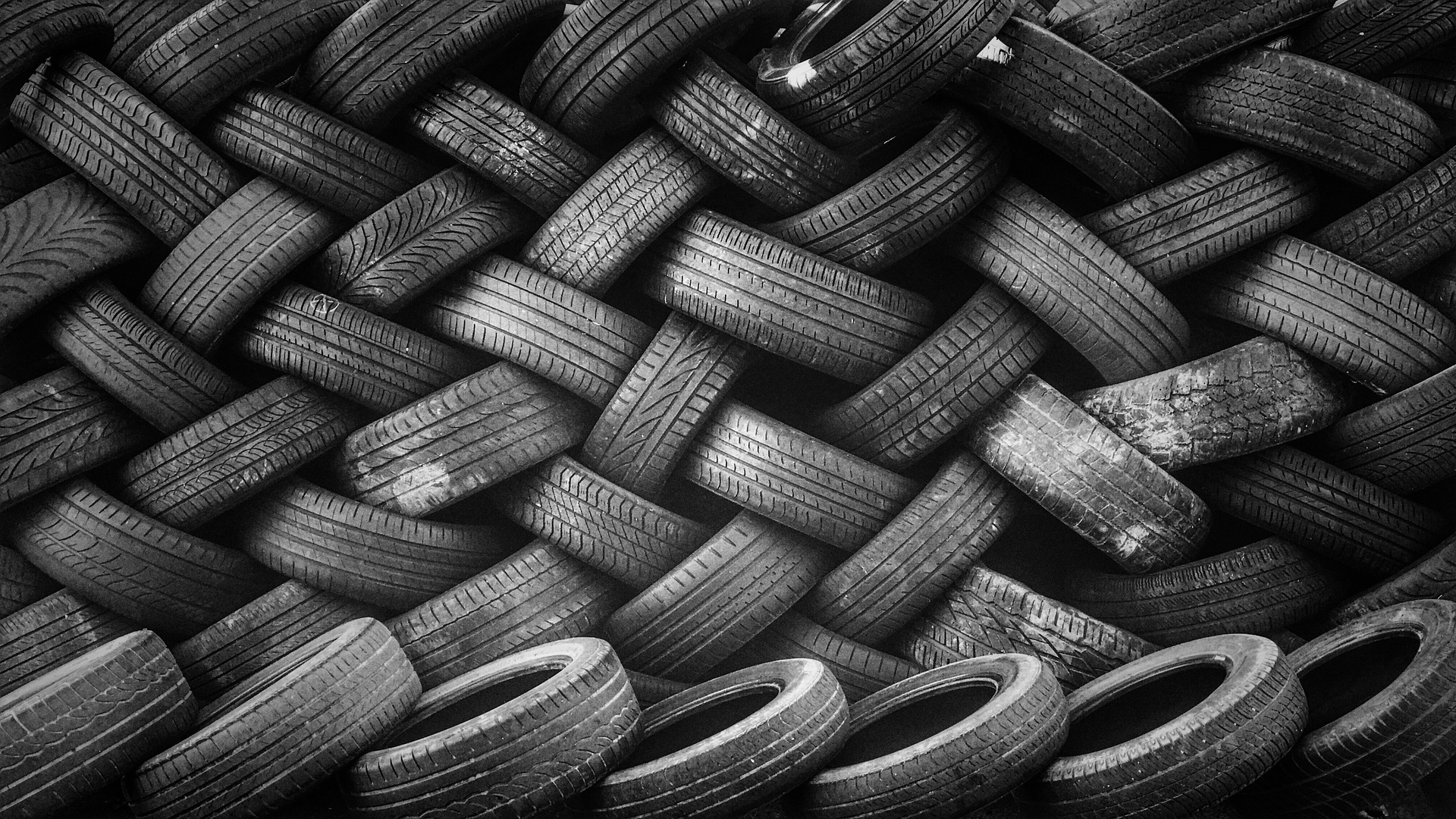Car recycling: What happens to the car when it is recycled?

Content
1. What happens to a vehicle during car recycling
If a car is badly damaged in an accident or it is of no economic benefit, it must be disposed of. Whereas in the past it was common to simply park old cars in the scrap yard, today a complex recycling process takes place. In the course of modern car recycling, valuable spare parts are removed and environmentally harmful substances are disposed of safely.
Read more: Mileage: This is how mileage affects used spare parts
What happens to a vehicle during car recycling
When a wrecked car is delivered to the car recycler, it goes through various steps in the course of recycling. Depending on the vehicle, the type of vehicle and the recycling company, the processes may differ slightly. As a rule, however, the recycling of end-of-life vehicles proceeds as follows:
- Removing the batteries and gas tank: The first step is to remove the batteries from the car to be disposed of in order to dispose of them in an environmentally correct manner. For vehicles with a gas tank, this is emptied or removed in accordance with the applicable safety regulations. Furthermore, the pyrotechnic components such as airbags are removed or rendered harmless by the trained personnel.
- Drain liquids: Cars contain various liquids, some of which are environmentally hazardous or flammable. The various liquids must be drained or extracted before the vehicle can be recycled further. These include, for example, fuels such as diesel or petrol, but also the cooling water, refrigerant from air conditioning systems or any remaining windscreen sprinkler liquid. All liquids must be carefully collected so that they can be disposed of separately afterwards.
- Removing spare parts: The third step in end-of-life vehicle recycling is the removal of spare parts. Every vehicle consists of thousands of individual parts, many of which can be reused without any problems. Also, some components, such as the catalytic converter, contain valuable raw materials like precious metals that can be recovered in the course of further recycling. Many recyclers mark the car parts immediately after removal and assess the condition and quality of the removed parts.
- Pressing the car: Once all fluids have been drained and all recyclable parts have been removed from the car, the vehicle is pressed. Most recyclers have their own scrap press for this purpose, which presses the body of the vehicle together with high pressure. The result is a cuboid block easy to transport. Since most car recycling companies do not have their own shredder, another transport step becomes necessary.
- Shredding the vehicle: In the fifth step, the remaining part of the worn-out vehicle is shredded. Since the shredding equipment required for this is expensive and complex in design, this step is usually not carried out at the car scrap yard itself. Instead, there are special companies that offer shredding in large-scale facilities. In the process known as fractionation, the remaining components of the vehicle are smashed into small pieces. This shredded material is then sorted by fully automated equipment. In this process, metal components such as the steel of the car body are separated out by magnets. The modern systems can also sort out other metals such as aluminium, as well as plastics, electronic components or rubber.
- Making spare parts available for purchase: The sixth and final step involves the car recycler once again. Here, the employees have meanwhile checked, sorted and often photographed the removed spare parts. The parts can be offered for sale directly afterwards, to be installed in another car. This is how a second life begins for the car parts. Customers have the opportunity to buy original car parts at a particularly favourable price.
The difference between car recycling and scrapping
The terms car recycling and car scrapping are sometimes used interchangeably, but this is not entirely correct. Especially in earlier times, old cars often ended up in a scrap yard without being disposed of in an environmentally suitable manner or recovered as raw materials. At the car scrap yard, however, car drivers and mechanics could dismantle spare parts themselves at low cost.
What remained of the old car was then scrapped in some way. Modern car recycling has a different approach. Here, the aim is to remove as many intact parts and raw materials from the car as possible and to feed them into a further life cycle. Scrapping in the actual sense only takes place after these steps. Even then, materials and raw materials are again separated by type.
Advantages of modern car recycling
- Environmental protection: In the course of environmentally correct car scrapping, all hazardous liquids are collected and disposed of in accordance with regulations. The remaining components are also subdivided according to material and type and recycled in an environmentally friendly manner in each case.
- Spare parts: Car recyclers also reduce the burden on the environment by removing spare parts that are still intact. These parts can be installed in other cars without any problems. Drivers thus have the opportunity to acquire original car parts – g. an engine – at a favourable price.
- Proof of recycling: Certified car recyclers will issue proof of the environmentally correct disposal of the car upon request. In Germany, such a certificate of destruction is required in order to be able to finally decommission the vehicle at the registration office.
- Collection: Many car recyclers offer free collection of the worn-out vehicle. Especially in the case of vehicles that are no longer roadworthy after an accident or engine damage, this is a great advantage.
How car recyclers offer used spare parts on Autoparts24
Numerous car recyclers from all over Europe now offer their spare parts on Autoparts24, and new recyclers are added regularly. A prerequisite for selling car parts on the Autoparts24 platform is registration as a dealer. Only reliable and certified car recyclers are admitted as partners and are allowed to present their car parts on the sales platform.
As soon as all requirements have been met, the range of used car parts can be entered into the system. For each spare part, important information such as the condition, the OEM number and, of course, the corresponding vehicle model is stored.
Important details such as the mileage of the car when the car parts were removed, or the colour are also listed. All information, as well as numerous original photos of the spare part, are later available to the customer. This makes it much easier to select the desired car part at Autoparts24.
Buy cheap parts from car recycling at Autoparts24
At Autoparts24 you can easily buy used spare parts without first having to contact various car recyclers. The parts you need are conveniently placed in the shopping basket at the click of a mouse and delivered promptly to your home or workshop once the order has been completed.
To make sure that you order the right part, you should compare the OE number or original number of the part in question. The detailed photos attached to each spare part also enable a good comparison between the existing car part and the one on offer.
Used parts: How to check the quality of used car parts
If the car is broken, it can be repaired cheaply thanks to inexpensive used parts. However, all spare parts from car recycling should be comprehensively checked. What has already been done by the car recycling company when you buy online,…
Read more
10 most frequently purchased car parts from car breakers/junkyard
Many people prefer to go with the cheaper option and source auto parts from junkyards when a car breaks down. This is entirely normal and ends up saving the car owner some money – and in addition is good for…
Read more
Advantages of shopping scrap car parts online vs. going to the local breaker yardsl
If you’re the kind of person who does repairs on your own car or likes to save money on finding the right parts yourself, then you’ve probably tried finding and buying parts at the local car breaker/junkyard. But there are…
Read more
Top guides
- Injection system in the car explained simply - parts and function of the injection...
- Maintenance and repair of electric cars: what can your normal garage do?
- Increasing performance with chip tuning: benefits, risks and tips
- Guide: Computer systems and software in your car
- Which electric car parts need repair or replacement most often?
- What is a solid-state battery for electric cars?
- All about engine sensors: from combustion engines to electric cars
- Increase the range of an electric car: How every electric car gets further
- Electric car battery life: How to extend the life of the battery
- What is the compression of a car engine?
- This is the cubic capacity of a car engine
- Internal combustion engine valves: function, defects and repair
- Core components of the internal combustion engine - parts and functions
- Engine lubrication in cars: components, function and defects
- The environmental impact of manufacturing new car parts
- All about pollutant classes and their role in environmental protection
- Engine overhaul: What is an engine overhaul and how much does it cost?
- OEM car parts manufacturing: the key components of the sector
- Understanding engine power - insight into the technology of the car engine
- The steering system of the car - structure and operation
- The car's braking system - structure, parts and function
- Engine types in the car: V-engine, in-line engine and boxer engine explained
- 8 tips before buying a used electric car
- Distinguish OEM parts, aftermarket and counterfeit car parts
- The EPC indicator light is on or flashing: What to do?
- Master brake cylinder: function, defect detection and repair
- OEM car parts for hybrid and electric cars
- Used youngtimer and classic car parts - the best tips
- Cruise control: Function and repair of the cruise control system in the car
- Exhaust system: Everything you need to know about parts and function of the exhaus...
- Locking system: security and reliable locking on the car
- The engine's air intake system - parts, function and replacement
- Brake caliper defective? How to replace it yourself
- Fuel system: parts of the fuel supply from the tank to the cylinder
- Air conditioning system: function and components of your car air conditioning syst...
- The clutch: structure and function explained simply
- Detecting and replacing a defective fuel pump
- Surprised? So many pumps work in your car
- The most common causes of a defective electric car
- The 6 most important safety components of your car
- Identify and repair a defective starter in a flash
- 5 common chassis problems and how to fix them
- 10 unknown car parts that many drivers do not know about
- Engine cooling: function and important components of the cooling system
- Differences between petrol and diesel engines
- All-wheel drive: How the mechanics and components of all-wheel drive work
- Engine control unit car: Everything about components and functioning
- Defective engine control unit: causes, symptoms and repair
- HP vs. torque: What is the difference between power and torque?
- EV motors basics: How are they built, how they work and differ from combustion eng...
- The chassis: overview and function of all suspension components
- Used electric car parts: What to look out for
- The importance of the chassis number when buying used car parts
- ABS pump defective? Function, repair and replacement
- Injection nozzle defective? Diagnosis, cleaning and changing the injection nozzles
- Alternator defective? What symptoms occur and when to change the component
- Water pump defective? Symptoms and how to repair or change it
- Steering gear defective? What are the symptoms and when should the component be re...
- Lambda sensor defective? What are the symptoms and can I clean the sensor?
- Defective air conditioning compressor - what are the symptoms and when should the ...
- Intake manifold defective? Replace gasket or clean manifold?
- Exhaust manifold leaking? Symptoms of a defective exhaust manifold or gasket and w...
- Turbocharger defective? Repair or change?
- Servo pump defective? What symptoms occur and when you should change the part
- Clutch broken? - These symptoms indicate a defect in the clutch
- Common problems and repair of defective drive shafts
- Causes of engine noise and what to do about it?
- What can car diagnostic devices do and do I need an OBD scanner?
- When and how to replace brake discs and brake pads
- Brake warning lamp lights up - causes and what to do?
- EGR valve defective: Avoid engine problems and clean EGR valve
- Improve fuel consumption: How your car uses less fuel
- Squeaking brakes: Why brakes squeak and how to get rid of it
- Safely jacking up a car: How to jack up a car using a jack and jack stands
- How a defect in the muffler becomes noticeable and how it is replaced
- E-car motor: These electric car parts you can replace yourself
- Engine overheated: What you should do if the engine overheats
- Engine check lamp lights up: What you should do as a motorist
- The engine code: What does the code mean and where can I find it on the car?
- Tools for car repair: These 10 tools you should own
- Car repair mistakes: These are the 7 most common car repair mistakes
- The gearbox code: What does the code mean and where can it be found on the gearbox...
- Used parts: How to check the quality of used car parts
- Vehicle transmission: What is the difference between manual and automatic transmis...
- Mileage: This is how mileage affects used spare parts
- Car recycling: What happens to the car when it is recycled?
- OEM original parts or aftermarket: these are the differences
- Advantages and disadvantages of new and used car parts
- Starting problems? Top 9 reasons why your car does not start
- What’s that smell from my car? Top causes and cures
- Advantages of shopping scrap car parts online vs. going to the local breaker yards...
- 10 most frequently purchased car parts from car breakers/junkyard
- Important car parts and their function
- Common car engine problems: Diagnosing, Troubleshooting and Fixes
- Best tips for setting up your own home car workshop
- 7 Car parts replacements and repair tasks you should not do yourself
- DIY Car Maintenance and Repair Tasks
- Guide: How to Maintain and Protect Your Car Engine
- Best practices for Engine Rebuild
- Common Causes of Rear Differential Noise, troubleshooting, and how fix it
- Common Causes of power steering noise and how fix it
- Your Guide to Car Engine Components and Functions
- Licence plate and VIN information
- Top 10 of the most popular brands in second-hand autoparts
- France is just so cool


